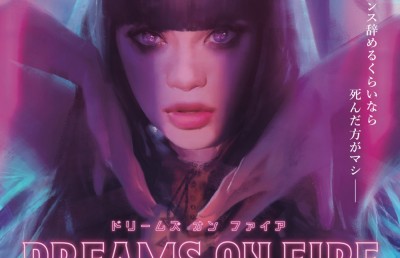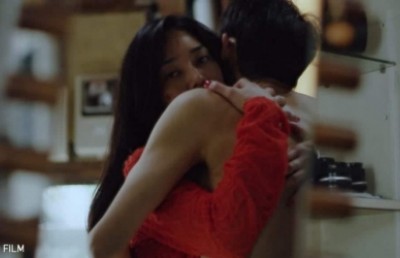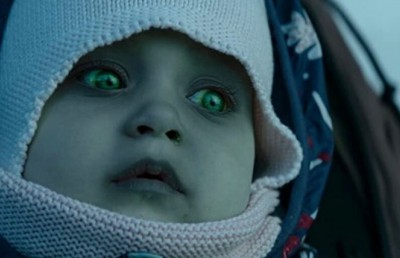Canadiana at Fantasia 2020
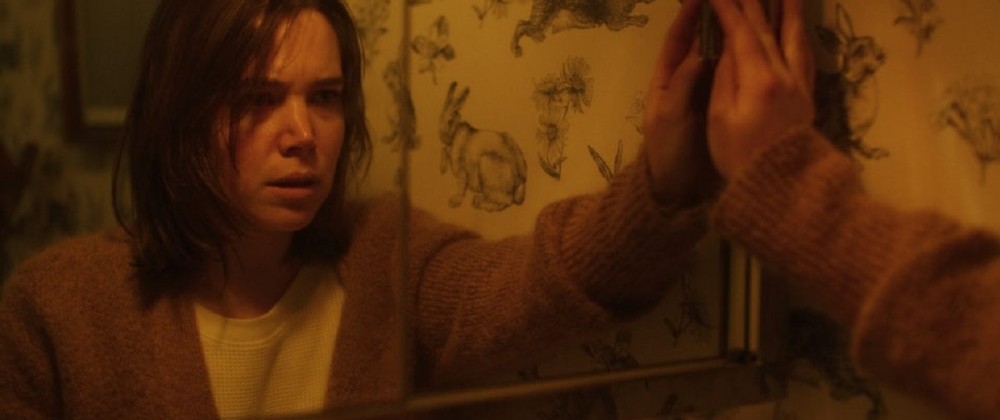
In this extension of my Fantasia 2020 report I will discuss five very different Canadian films I enjoyed, Slaxx (2020, Elza Kephart), The Oak Room (2020, Cody Calahan), Bleed With Me (Amelia Rose, 2020), Come True (2019, Anthony Scott Burns) and Hail to the Deadites (2020, Steve Villeneuve): a satirical anti-corporate film about killer jeans; an engrossing, dialogue rich noir that operates at the level of meta-storytelling; a visually sumptuous psychological horror film about co-dependency; a science-fiction film about dream therapy; and a documentary on fans of the Evil Dead franchise. Not a bad mix.
Slaxx (Elza Kephart, 2020)
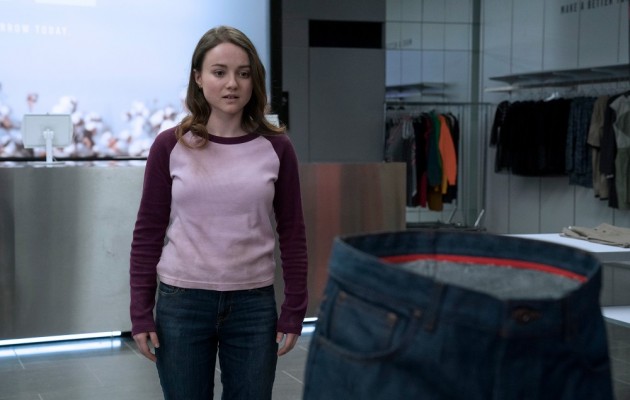
Elza Kephart made her Fantasia debut many years ago with her fun, black and white 2003 retro zombie film Graveyard Alive, and returns with her most recent feature, Slaxx (2019, Elza Kephart), a film which has the potential to be a genuine cult classic item. At a taut 77 minutes, the films is fat-free –like the customers who squeeze into the film’s slim designer jeans. The film is set within the world of a Gap-like clothing store fixated on branding and the youth market. The fact the film makes the head male character so nasty may be seen as a weakness in the writing, but it is set at the level of caricature as a template for the evil capitalist corporation behind the slickly designed store. This satire fits the current trend of political horror, without pushing the theme too far. In a post film panel discussion Elza Kephart mentioned a documentary on the global impact of the fashion industry, The True Cost (2015) and the ‘unpacking’ videos as an influence. This is reflected in the ‘influencer’ character and the vapid level of self marketing and corporate sponsorship as free form advertising. The look of the store and logo, Canadian Cotton Company, is modelled after Gap which also had associated its brand with various forms of social engagement. Here too the company advertises itself as being sweatshop free, GMO free, and its logo obsessed mantra pushes this social attitude, but as a marketing tool more than genuine social concern, captured in the company logo each employee must recite daily, “Make today a better tomorrow”.
The film opens with a lateral tacking shot of a cotton field, where we see a young, under-age Indian worker who takes the cotton plants to a thresher. We later cut back to get the full meaning of the scene, from the POV of this girl as a ghost. The worker is 13 year-old girl Keerat (Pritha Mazumdar), whose scarf gets caught in the teeth of the cotton thresher and her body is pulled into the gear mechanism. Her blood spills into the cotton and into the container that carries the shipment of pants to North America. The jeans become possessed by the ‘yurei’ of the dead girl. The tradition of yurei is an interesting parallel since in the classic Japanese ghost story the ghost returns because she is not at rest because of an unjust death. And only when she gets her justice can she rest at peace. Keerat is in that sense the classic ghost found across many Asian supernatural stories. And where this is unique is that even when the good characters try to convince her that she is killing innocent people along with the guilty, she does not renounce her vengeance.
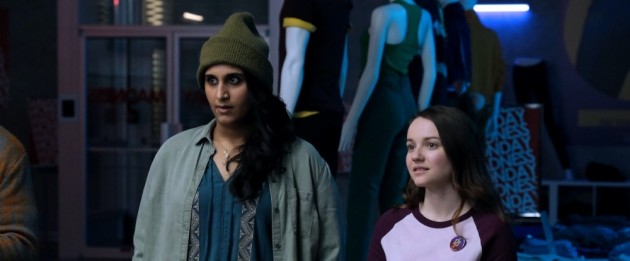
In one of the film’s best set piece moments, the doors open for Monday Madness sale of the new “stretch slaxx” jeans and the crowd stampede causes the death of an innocent clerk. Then the ‘tainted’ jeans who have all staged themselves on the racks, attack and kill all the customers. The special visual effects of the living, moving pants is a make or break it visual effect and thankfully works well. Very well. And surprisingly there is no CGI but a combination of puppetry with poles manipulating the jeans from behind, in front of a green screen. The theme of haunted clothes that kill reminded me of the Dario Argento TV film from the second season of Master of Horror, Pelts (2006), and the recent Peter Strickland film, In Fabric (2018), which feature haunted racoon minks and a haunted dress respectively.
By far the film’s most infectious scene, and the one that can help stamp a cult film label on this film, is the one where Libby (Romane Denis), an Indian employee of the store, connects with the ghost of Keerat through her music. Libby is listening to music on headphones, singing a Bollywood song, and in the background behind her we see a pair of jeans on a mannequin, dancing in unison with her. The choreography is funny, surreal and a little bit creepy.
The Oak Room (2020, Cody Calahan)
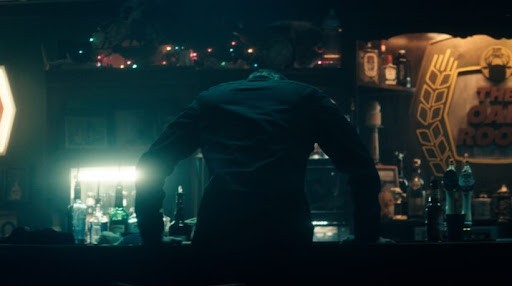
The production company of The Oak Room, Black Fawn Films, has established itself as somewhat of an anomaly in the Canadian landscape: a production company which has successfully carved out a space for itself in commercial genre cinema, something which we have not seen since the glory days of Cinepix. Since 2009 Black Hawk Film has produced over 20 films and Fantasia has been featuring the films of this Ottawa-based production company since their beginning. I myself have covered them in earlier reports, writing about their early films, the rape revenge thriller Sweet Karma (2009, Andrew Thomas Hunt) and the psychological thriller Neverlost (Chad Archibald, 2010). A full list of their films can be seen at their website: https://www.blackfawnfilms.com/BFF-2015-FILMS.html.
The Oak Room represents a step away from the usual horror fare of the prolific Black Fawn films, but not too far, as it is a film noir with tension and anticipation of violence not too removed from horror. Director Cody Calahan’s latest film, the entertaining retro 1980s set horror film Vicious Fun (2020) can currently be seen on the Shudder streaming service. The Oak Room actually has the feel of Hateful Eight: single (mainly) bar location; strangers with hidden agendas; grizzled men (not a woman in sight); long meta-dialogue scenes; and stories about storytelling. The actors are all great and the dialogue both noirish but with a contemporary feel. Characters sit and tell stories, stories that enthrall their listener; and stories that sometimes wrap around and come back upon themselves; or relate to each other through recurring motifs (people being cold from the bitter winter, snowstorm brewing outside, shot of the window with blizzard outside). The opening shot of a perfectly lit and symmetrically framed beer bottle on the bar counter, and a fight between two men in the bottom background establishes that violence is happening or going to happen. A young man, Steve (RJ. Mittie), enters an empty bar, and surprises the tending bartender, Paul (Peter Outerbridge), who is closing up and none too happy to see this person from his past. Paul was good pals with Steve’s father Gordon (Nicholas Campbell), who died three years earlier, which is the last time they Steve and Paul met. Paul feels aggrieved that Steve did not return for his father’s funeral, blames him indirectly for his death, and for leaving him with all the funeral payments. Steve tries to repay him with a “story”, which then shifts the film’s focus to another bar, two other men in a similar situation, bartender Michael (Ariel Mitter) closing his bar, and another stranger, Richard (Martin Roach) entering. Again, a story is exchanged with the bartender talking, the stranger listening. The tension is thick, with the banter between the two men testy, always a few choice words away from a fight. We cut back to Steve and Paul, Paul upset at the lameness of the story, urging Steve to “Goose up the truth”. Paul tries to get Steve to understand how his father felt betrayed by telling a story about Gordon, which then leads to Gordon telling Paul another story about an creepy hitchhiking experience he had as a young man (Gordon here played by his own son Campbell Coal). It is a foreboding tale about a driver who never once made eye contact with young Gordon, and only spoke a few opaque phrases (“Where do you think you are going?” “Do you think you are going to heaven or hell….We are all going to hell”). Gordon’s dialogue here is beautiful, the heartfelt words of a man looking back on his life with nothing but regret and remorse, a remorse which Paul then throws into Steve’s face, blaming him for throwing away an opportunity earned by his father for a better life.
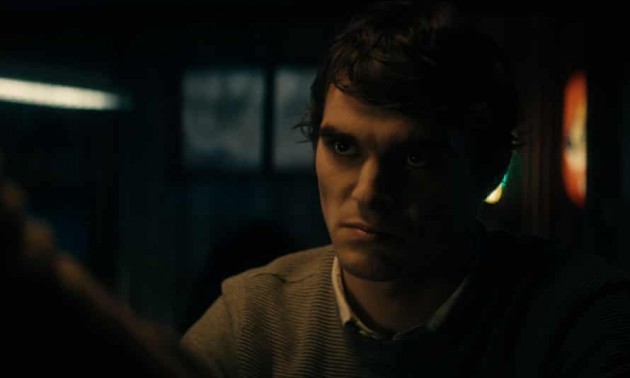
Back to the present. Steve promises him that the story will get better when he tells him the first part. Another variation on the same dynamic. Only now Michael is the stranger entering the bar, and another man is the bartender. The layering of the story now instantly instills a knot in our stomach, knowing that Michael will surely murder the innocent bartender for a job we can only surmise. And that the stranger in the story within the story, Richard, will also be murdered by Michael for being a bystander. The kicker is that Steve knows the brutal details of a crime not yet known publicly because a town dunk was actual asleep in a corner of the bar and overheard everything, including a reveal which implies that the hired killer stopped at the wrong bar, and that Paul was the intended victim.
The Oak Room is based on a play and although the origins are noticeable from the static locations and heavy dialogue, it still feels cinematic in the way it plays heavy on the meta, and pays nice attention to camera movements, lighting and framing. It is no doubt an actors movie and gets its main power from the performances, but the dialogue is heavily imbued with human sorrow from the most unlikely of places: bruised, compromised masculinity.
Bleed With Me (Amelia Rose, 2020, Canada)
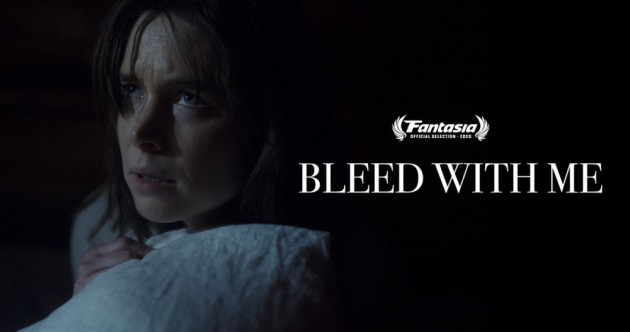
Bleed With Me is an interesting slow burn psychological horror film with a female ambience that overlaps with other recent claustrophobic and femme trauma films, some of which played at Fantasia, like Swallow (Carlo Mirabella-Davis, 2019), Relic (Natalie Erika James, 2020), The Lodge (Severin Fiala, Veronika Franz, 2019), The Banishing (Christopher Smith, 2019), Saint Maude (Rose Glass, 2019), The Power (Corrina Faith, 2020), Let’s Scare Julie (Jud Cremata, 2019), and Homewreckers (also Canadian, directed by Zach Graye, 2019).
Rowan (Lee Marshall) is invited to a remote cabin in the wintry woods (location being two hours outside Montreal) by her friend and work colleague, Emily (Lauren Beatty), and also Emily’s boyfriend, Brendan (Aris Tyros). Both women are dealing with a past trauma, as suggested by the boyfriend’s referencing their past. Rowan is a cutter and Emily has cultivated a thirst for blood stemming from the loss of her younger sister when she was 10 years old. These conditions are not meant to be taken literally but as a way to suggest co-dependency: one bleeds, the other drinks the blood. The passive aggressive actions and the sexual suggestions invokes Persona, a film whose influence on contemporary femme-themed horror continues to grow. Persona also pits two co-dependent women who draw from each other’s emotions, Alma, a nurse, and Elizabet, an actress who has stopped talking since her last theatrical role. The scenes of Emily visiting Rowan in her bedroom at night while asleep are styled like a vampire about to attack a victim, echoing a key nighttime/dream scene in Persona, including a moment where Elizabet sucks blood from Alma’s forearm. During a Q&A director Rose mentioned the Munchausen syndrome by proxy, of which once again Persona can be seen as a template. The Munchausen syndrome by proxy is a psychological disorder where a person in a caregiving role (mother, nurse, etc.) seeks medical attention for the person under their care for a condition which they make up, exaggerate or in some cases facilitate. Like Persona the film hinges on a subjective understanding of the reality we see. How much of the film is in Rowan’s imagination? Is Emily drugging her and drawing the blood? Or is she genuinely helping her? This dynamic is in the tradition of the theme of gaslighting, which goes back to the Gothic story and 1940s melodramas. The end does posit a conclusion: Rowan turns and stabs Emily in the neck. She leaves for the woods, sleepwalking (which she does earlier), feints and is then picked up by a returning Brendan, who finds Emily lying in a pool of her blood. Director of photography René Arseneau’s lighting and use of set and landscape is impressive for a quickly shot low budget film. Arseneau bathes both the rustic cabin interiors and snowy exterior woods with a soft, warm, mist-like hue and with dark shadows that hide character intentions. The shots of Rowan in the woods at night, with blue moonlight amplified through trees and reflecting snow is not only eerie but gives the film a more expansive visual look than the budget would suggest.
Come True (2019, Anthony Scott Burns)
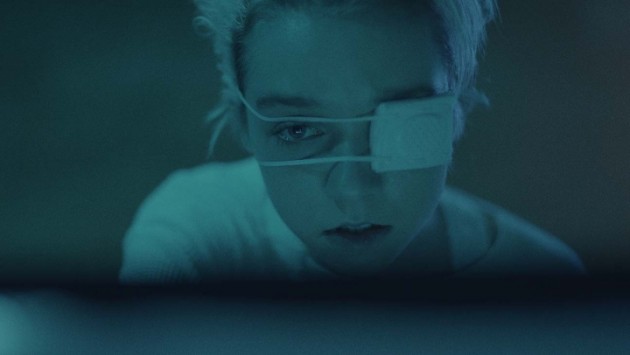
Come True is shot in Edmonton, Alberta and uses Jung, rather than the more common horror source of Sigmund Freud, as a template to navigate the intersections between art, technology and psychological trauma. Films that deal with dreams tread a potentially dangerous zone. The medium of cinema can be dream-like and oneiric, and cinema that tries to be dream-like can be enchanting. The parallels between cinema and dreams are there: both take place in a dark space, have the ‘viewer’ immobilized’, and in a more subdued or heightened state; feel in a virtual present; necessitate a certain ‘withdrawal’ from reality; and feel primarily visual and two-dimensional. But all of this can only exist as a loose analogy. When we watch a film we know we are awake, we can get up and leave at anytime, etc. But cinema that tries to recreate a dream, to visualize what a person’s dream looks like can be trite or too obvious. Like the art biography that tries to capture the artist’s creative process. It can never capture what is ineffable. There are very few films that have succeeded in making dreams real. The science fiction films La Jetée (Chris Marker, 1963) and The Lathe of Heaven (David R. Loxton, Fred Barzyk), and the docu-drama by Rodney Ascher that dramatizes sleep paralysis experiences, The Nightmare (2015) are three that come to mind.
Come True manages to play these two states –being dream-like and visualizing dreams— well. The moments of seeing the dreams recall the dramatizations of waking nightmares from Rodney Ascher’s The Nightmare, as a sort of collective memory. In Come True a small research team pays volunteers with sleep disorders to become part of their test group. The central subject becomes an 18 year old, waif-like woman named Sarah (Julia Sarah Stone), who we surmise from her social interactions and her bizarre relationship with her mother, as someone not in a good place. We never see her mother interact with her, and is seen once from afar, as Sarah waits until she leaves the house before going in to wash, grab some food and run out again. The first time we see Sarah she wakes up on a park slide. All throughout she has no place to sleep so slumbers where she can. She gets paid to sleep but is rigged up in a white padded suit attached with wires to a control center, and a padded helmet. The research group is run by an odd looking Dr. Meyer (Christopher Heatherington), who wears the ugliest thick black glasses imaginable and is cursed with a perennially sweaty complexion. But while Dr. Meyer sits in the background overseeing results, a young, bookish man, Jeremy (Landon Liboiron), and the lead controller, Anita ( Carlee Ryski), take over the study.
Jeremy becomes close and protective of Sarah. Sarah is a sufferer. When she is locked in, her dreams are depicted in two ways: we see them in an old school cathode tube computer screen, and in a more lush, fluid, video game styled trip through dank (almost Stalkerian) tunnels and dark voids. These are filmed all in CGI, but with an intentional artificiality. I was reminded of the dream landscapes of the video game turned film franchise Silent Hill. The main scary trope dream presence is a figure of a tall, dark shadow figure with yellow dots for eyes, an image that recalls the supernatural presence in Uncle Bonmee Who Can Recall His Past Lives (Apichatpong Weerasethakul, 2010). Where in Rodney Ascher’s The Nightmare the dark figures are Freddie Krueger like Boogeymen, here the boogeyman is a Slenderman type figure (again, more Jung than Freud). Soon the dream world begins to slip into Sarah’s real world. The first signs are her blood shot eyes and then stigmata like blood dripping down her cheeks. Her sleep walks are in reality but then her environment becomes her dream, and in the climax, she is sleepwalking along a street at night, with Jeremy and Anita following with their dream machine. The landscape around them becomes more and more dreamlike, until they encounter the same yellow eyed figures that seems to haunt everyone’s dreams (Jung).
In one striking scene Sarah finds Jeremy tied to a bed sharing his own inner world and she turns the table by seeing into his dream —the patient switching places with the psychoanalyst— and Sarah makes an appearance as a vampiric lover (another echo of Persona). This feels like one of those fantasies where someone sees what another person is thinking, so the first chance she gets she mentions that seeing his dream, a bond which leads to sex. Overlaying everything and tying all levels of reality into an organic whole is the impressive music and sound design by the two-person band Electric Youth and director Burns himself writing under his composer pseudonym, Pilotpriest. The Toronto-based electronic pop duo Electric Youth, who are lifetime partners Bronwyn Griffin and Austin Garrick, are friends with Scott Burns and collaborated on an earlier ill-fated project. Burns had hired Electric Youth to compose the soundtrack for his science fiction film Breathing, but Burns abandoned the project over creative differences with the film’s producer. Electric Youth followed by abandoning the project in support of Burns, but still released what would have been the soundtrack to Burns’ original version (the result is a great soundtrack that shows the band in a more ambient, experimental form).
To return to the film, the final scene offers a partial resolution in the shape of a twist ending. Sarah finds herself in a overly saturated white bathroom and looks into the mirror and sees large fangs in her mouth. Her appearance here matches the version of herself that appeared in Jeremy’s dream. She now has turned full circle to become Jeremy’s fantasy. Her cell phone, which was stolen in an earlier scene where she fell asleep in the laundromat, and found by Jeremy in the woods, shows up on the toilet seat of her bathroom. A message appears on the cell phone. The camera does a beautiful slow pan from her vampiric mirror image to the face of the phone, close enough to read the text message. A cut brings us closer and we discover that Sarah has been in a coma for 20 years, which the team have been trying to wake her from using these new medical techniques. The twist is a novel take on the “it was all a dream” ending. No doubt the film will reward repeat viewings to pick up on the clues dropped in the film, from the references to Philip K. Dick, to the retro touches that we see (her mother’s 1970s or 1980s car parked in the driveway). You can even say the synth score from Pilotpriest and Electric Youth has a “20 years ago” vibe to it.
Hail to the Deadites (2020, Steve Villeneuve)
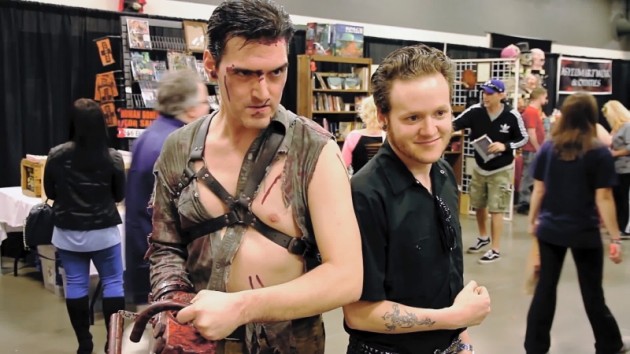
Montrealer Steve Villeneuve’s Hail to the Deadites is a great documentary about horror fans, and most directly, fans of the Evil Dead films and its franchise. Fan based films are not rare. Fantasia has featured a few over the years, like last year’s The Phantom of Winnipeg and Troll 2; The Best Worse Movie (and this year there is Alien on Stage, a documentary about an amateur theatre troupe in London who stage a play version of Ridley Scott’s Alien). Sam Raimi is absent but his brother Ted makes an appearance, as does the Chin himself Bruce Campbell and his brother Kevin Campbell. The biggest of the Evil Dead team in terms of their input in the doc is the special effects artist Tom Sullivan, who comes across as an amiable person. This documentary does not pull punches in terms of the way it represents the Evil Dead fans. And it really is a film about the fans and not the films since there is very little said about the films. It is populist as well, as there is only one scholar in it, the Canadian Andre Loiselle and I assume he was selected because they were in Ottawa, where Loiselle teaches, so he would have been easy to contact. Loiselle is a scholar of Canadian horror and horror in general, so he had a few things to say in terms of the appeal of the film and in particular the acting performances of Bruce Campbell and how he is a cult actor who is able to negotiate playing straight but also playing with a sense of self parody.
The film presents these fans as regular people who just happen to have this passion for a film series that made its mark in the early 1980s and has grown in stature. As most horror docs reveal, horror fans come across as a very close knit group. And the horror creators often feel a connection to their fans, as we see in one of the more emotional moments in the film when Tom Sullivan plays part in the engagement and marriage proposal of a ‘Deadite’ couple, with the proposal taking place in the memorabilia room of a Horror convention. The couple are clearly moved by Tom Sullivan’s video appearance at their wedding. Unfortunately, the end credits reveal that the couple divorced a year after the film.

Bruce Campbell is very forthright in his interactions with fans and what he feels about them, claiming there really are both kinds of fans that must be acknowledged: the problem ‘stalker’ fan and the fans that contribute to making his performances special, which can be very touching for an actor. There is a hint of criticism when he notes how surprised he is by the fans who line up for hours to meet him and then hardly speak or make eye contact with him.
There’s one passage in the film which is so touching I doubt anyone with a heart did not struggle to hold back the tears. It is the story of a DJ from Ohio, who tells us that he named his son Ash after the courageous nature of Bruce Campbell’s character. He then surprisingly pivots into a very personal story about how his son was born with a very rare heart problem. The man talks about how this baby suffered through one surgery after another and always survived. Until his final struggle. He catches us off guard when he recounts how his son’s body gave out during a surgery and how when the doctor had ended the life support system the baby still fought on and survived for another 10 or 15 minutes before he was pronounced dead. This story is made even more emotional when it is followed by footage of the baby at different stages of his very young life, including heartbreaking footage of the baby with incubator tubes sticking out of his chest. Even if at that point he had never met Bruce Campbell this is the sort of interchange between fans and stars that rises above the material of the obsession to become a touching human story.
The film also reveals that women can be just as obsessive about horror films as men, which is borne out when a woman wins a contest as the greatest Evil Dead fan. And another woman from Quebec identifies herself as a huge Deadite and runs a website on the film. The film brings us right into the homes of these fans allowing them moments of simple glory, showing off their most prized props from their Evil Dead collection. There is also a very strong Canadian content since the film is made by a Québec filmmaker (Steve Villenueve) and contains plenty of footage at Canadian-based horror events (a Québec horror monster convention and a Ottawa Evil Dead convention), all of which makes it a special ‘local’ showing at Fantasia. My guess is that there are more than a few Deadites among the Fantasia faithful.
Trailer: https://www.youtube.com/watch?v=VPBjjmdWdsw
Deadites Online: https://deadites.net/



